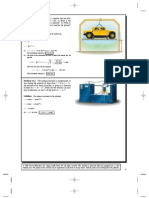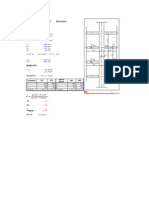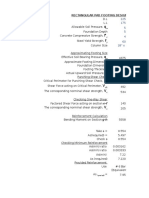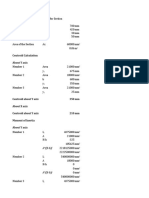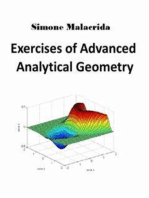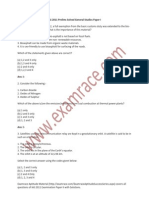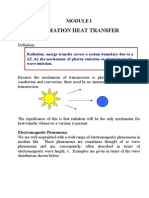Vector - Mechanics (Compatibility Mode)
Uploaded by
BalvinderVector - Mechanics (Compatibility Mode)
Uploaded by
Balvinder9/18/2013
1
Vectors
Vector classifications:
- Fixed or bound vectors have well defined points of
application that cannot be changed without affecting
an analysis.
- Free vectors may be freely moved in space without
changing their effect on an analysis.
Equal vectors have the same magnitude and direction.
Negative vector of a given vector has the same magnitude
and the opposite direction.
Engineers Mechanics- Review of Vector Algebra/Applications
Addition of Vectors
Parallelogram rule for vector addition
Triangle rule for vector addition
B
B
C
C
Q P R
B PQ Q P R
+ =
+ = cos 2
2 2 2
Law of cosines,
Law of sines,
P
C
R
B
Q
A sin sin sin
= =
Vector addition is commutative,
P Q Q P
+ = +
Vector subtraction
Engineers Mechanics- Review of Vector Algebra/Applications
9/18/2013
2
Addition of Vectors
Addition of three or more vectors through
repeated application of the triangle rule
The polygon rule for the addition of three or
more vectors.
Vector addition is associative,
( ) ( ) S Q P S Q P S Q P
+ + = + + = + +
Multiplication of a vector by a scalar
Engineers Mechanics- Review of Vector Algebra/Applications
Engineers Mechanics- Review of Vector Algebra/Applications
Addition of Vectors
A quantity which has magnitude and
direction, but doesnt follow
parallelogram law, cannot be a vector.
Can you name such a quantity?
Think in terms of associative property!!
Answer: Finite Rotation
9/18/2013
3
Application: Resultant of Several Concurrent Forces
Concurrent forces: set of forces which all
pass through the same point.
A set of concurrent forces applied to a
particle may be replaced by a single
resultant force which is the vector sum of the
applied forces.
Vector force components: two or more force
vectors which, together, have the same effect
as a single force vector.
Engineers Mechanics- Review of Vector Algebra/Applications
Rectangular Components of a Vector
cos F F
x
=
Vector components may be expressed as products of
the unit vectors with the scalar magnitudes of the
vector components.
F
x
and F
y
are referred to as the scalar components of
j F i F F
y x
+ =
F
May resolve a vector into perpendicular components so
that the resulting parallelogram is a rectangle.
are referred to as rectangular vector components and
y x
F F F
+ =
y x
F F
and
Define perpendicular unit vectors which are
parallel to the x and y axes.
j i
and
sin F F
y
=
Engineers Mechanics- Review of Vector Algebra/Applications
9/18/2013
4
Application: Addition of Concurrent Forces
S Q P R
+ + =
Wish to find the resultant of 3 or more
concurrent forces,
( ) ( ) j S Q P i S Q P
j S i S j Q i Q j P i P j R i R
y y y x x x
y x y x y x y x
+ + + + + =
+ + + + + = +
Resolve each force into rectangular components
=
+ + =
x
x x x x
F
S Q P R
The scalar components of the resultant are
equal to the sum of the corresponding scalar
components of the given forces.
=
+ + =
y
y y y y
F
S Q P R
x
y
y x
R
R
R R R
1 2 2
tan
= + =
To find the resultant magnitude and direction,
Engineers Mechanics- Review of Vector Algebra/Applications
Example-1
Two structural members A and B are bolted to
a bracket as shown. Knowing that both
members are in compression and that the force
is 20 kN in member A and 30 kN in member B,
determine, using trigonometry, the magnitude
and direction of the resultant of the forces
applied to the bracket by members A and B.
SOLUTION KEY
o Construct the force triangle
and apply the sine and
cosine rules.
Engineers Mechanics- Review of Vector Algebra/Applications
Example of a timber truss joint
9/18/2013
5
SOLUTION
Engineers Mechanics- Review of Vector Algebra/Applications
Example-1
A collar that can slide on a vertical rod is subjected to
the three forces shown. Determine (a) the value of the
angle for which the resultant of the three forces is
horizontal, (b) the corresponding magnitude of the
resultant.
SOLUTION KEY
o Since the resultant (R) is to be
horizontal, sum of the vertical
comp. of the forces, i.e., R
y
=0.
Example of an Umbrella
Engineers Mechanics- Review of Vector Algebra/Applications
Example-2
9/18/2013
6
1 - 11
0
y y
R F = E =
( ) ( ) 90lb 70lb sin 130lb cos 0 + =
( ) ( ) 13 cos 7 sin 9 = +
( )
2
13 1 sin 7 sin 9 = +
( ) ( ) ( )
2 2
169 1 sin 49 sin 126 sin 81 = + +
( ) ( )
2
218 sin 126 sin 88 0 + =
sin 0.40899 =
= 1 . 24
(a) Since R is to be horizontal, R
y
=0
Then,
Squaringbothsides:
Solving by quadratic formula:
or,
SOLUTION
Engineers Mechanics- Review of Vector Algebra/Applications
Example-2
1 - 12
117.0lb R =
or,
Engineers Mechanics- Review of Vector Algebra/Applications
Example-2
9/18/2013
7
Rectangular Components of a Vector in Space
1 cos cos cos
2 2 2
= + +
z y x
Components of the vectorF
( )
k j i
F
k j i F
k F j F i F F
F F F F F F
z y x
z y x
z y x
z z y y x x
cos cos cos
cos cos cos
cos cos cos
+ + =
=
+ + =
+ + =
= = =
is a unit vector along the line of action of
and are the direction
cosines for
F
z y x
cos and , cos , cos
2 2 2
z y x
F F F F + + =
Engineers Mechanics- Review of Vector Algebra/Applications
Application: Rectangular Components of a Force Vector in Space
2 2 2
z y x
d d d d + + =
The magnitude of the force vector is
F and the direction of the force is
defined by the location of two
points,
( ) ( )
2 2 2 1 1 1
, , and , , z y x N z y x M
( )
d
Fd
F
d
Fd
F
d
Fd
F
k d j d i d
d
F F
z z d y y d x x d
k d j d i d
N M d
z
z
y
y
x
x
z y x
z y x
z y x
= = =
+ + =
=
= = =
+ + =
=
1
and joining vector
1 2 1 2 1 2
d
d
d
d
d
d
z
z
y
y
x
x
= = = cos ; cos ; cos
Engineers Mechanics- Review of Vector Algebra/Applications
9/18/2013
8
Scalar Product of Two Vectors
The scalar product or dot product between
two vectors P and Q is defined as
( ) result scalar cos PQ Q P = -
Scalar products:
- are commutative,
- are distributive,
- are not associative,
P Q Q P
- = -
( )
2 1 2 1
Q P Q P Q Q P
- + - = + -
( ) undefined = - - S Q P
Scalar products with Cartesian unit components,
0 0 0 1 1 1 = - = - = - = - = - = - i k k j j i k k j j i i
( ) ( ) k Q j Q i Q k P j P i P Q P
z y x z y x
+ + - + + = -
2 2 2 2
P P P P P P
Q P Q P Q P Q P
z y x
z z y y x x
= + + = -
+ + = -
Engineers Mechanics- Review of Vector Algebra/Applications
Applications: Scalar Product of Two Force Vectors
Angle between two force vectors:
PQ
Q P Q P Q P
Q P Q P Q P PQ Q P
z z y y x x
z z y y x x
+ +
=
+ + = = -
cos
cos
Projection of a force vector on a given axis:
OL
OL
P P
Q
Q P
PQ Q P
OL P P P
= =
-
= -
= =
cos
cos
along of projection cos
z z y y x x
OL
P P P
P P
cos cos cos + + =
- =
- For an axis defined by a unit vector ():
Q
Q
=
Note:
Engineers Mechanics- Review of Vector Algebra/Applications
9/18/2013
9
Vector Product of Two Vectors
Vector product of two vectors P and Q is defined
as the vector V which satisfies the following
conditions:
1.Line of action of V is perpendicular to plane
containing P and Q.
2.Magnitude of V is
3.Direction of V is obtained from the right-hand
rule.
sin Q P V =
Vector products:
- are not commutative,
- are distributive,
- are not associative,
( ) Q P P Q =
( )
2 1 2 1
Q P Q P Q Q P + = +
( ) ( ) S Q P S Q P =
Engineers Mechanics- Review of Vector Algebra/Applications
Vector Products: Rectangular Components
Vector products of Cartesian unit vectors,
0
0
0
= = =
= = =
= = =
k k i k j j k i
i j k j j k j i
j i k k i j i i
Vector products in terms of rectangular
coordinates
( ) ( ) k Q j Q i Q k P j P i P V
z y x z y x
+ + + + =
( ) ( )
( )k Q P Q P
j Q P Q P i Q P Q P
x y y x
z x x z y z z y
+
+ =
z y x
z y x
Q Q Q
P P P
k j i
=
Engineers Mechanics- Review of Vector Algebra/Applications
9/18/2013
10
Application: Moment of a Force About a Point
Moment of a force produces a turning action on a
rigid body
The moment of a force F about O is defined as
F r M
O
=
Engineers Mechanics- Review of Vector Algebra/Applications
r is the position vector of A from O
The moment vector M
O
is perpendicular to the
plane containing O and the force F.
Magnitude of M
O
measures the tendency of the force
to cause rotation of the body about an axis along M
O
.
d is the perpendicular distance of the line of action
of Force F from O. The sense of the moment may be
determined by the right-hand rule.
Fd rF M
O
= = sin
Engineers Mechanics- Review of Vector Algebra/Applications
Examples: Application of moments
9/18/2013
11
Application: Rectangular Components of the Moment of a Force about origin
( ) ( ) ( )k yF xF j xF zF i zF yF
F F F
z y x
k j i
k M j M i M M
x y z x y z
z y x
z y x O
+ + =
=
+ + =
The moment of force F applied at A about O,
k F j F i F F
k z j y i x r F r M
z y x
O
+ + =
+ + = = ,
Engineers Mechanics- Review of Vector Algebra/Applications
Appl i cati on: Rectangul ar Components of the Moment of a Force about an
Arbi trary Poi nt
The moment of force F applied at A about B,
F r M
B A B
=
/
( ) ( ) ( )
k F j F i F F
k z z j y y i x x
r r r
z y x
B A B A B A
B A B A
+ + =
+ + =
=
/
( ) ( ) ( )
z y x
B A B A B A B
F F F
z z y y x x
k j i
M =
Engineers Mechanics- Review of Vector Algebra/Applications
9/18/2013
12
A 36-N force is applied to a wrench to
tighten a showerhead. Knowing that the
centerline of the wrench is parallel to the x
axis. Determine the moment of the force
about A.
Example-3
SOLUTION KEY
o Find out the position vector of the
point C .
o Get the components of the applied
force (F) along X, Y and Z directions.
Engineers Mechanics- Review of Vector Algebra/Applications
Example - 3
/ A C A
= M r F
( ) ( ) ( )
/
215mm 50mm 140mm
C A
= + r i j k
( ) 36N cos45 sin12
x
F = ( ) 36 N sin45
y
F =
( ) 36 N cos45 cos12
z
F =
( ) ( ) ( ) 5.2926 N 25.456 N 24.900N = F i j k
where
,
,
0.215 0.050 0.140 N m
5.2926 25.456 24.900
A
=
i j k
M
( ) ( ) ( ) 4.8088N m 4.6125N m 5.7377N m = + i j k
and
( ) ( ) ( ) 4.81N m 4.61N m 5.74N m
A
= + M i j k
SOLUTION
Engineers Mechanics- Review of Vector Algebra/Applications
9/18/2013
13
Mixed Triple Product of Three Vectors
Mixed triple product of three vectors,
( ) result scalar = - Q P S
The six mixed triple products formed from S, P, and
Q have equal magnitudes but not the same sign,
( ) ( ) ( )
( ) ( ) ( ) S P Q Q S P P Q S
P S Q S Q P Q P S
- = - = - =
- = - = -
( ) ( ) ( )
( )
z y x
z y x
z y x
x y y x z
z x x z y y z z y x
Q Q Q
P P P
S S S
Q P Q P S
Q P Q P S Q P Q P S Q P S
=
+
+ = -
Evaluating the mixed triple product,
P
Q
S
=volume of parallelepiped
Engineers Mechanics- Review of Vector Algebra/Applications
Application: Moment of a Force About an Axis Passing Through the Origin
k z j y i x r
+ + =
Moment M
O
of a force F applied at the point A
about a point O,
F r M
O
=
Scalar moment M
OL
about an axis OL is the
projection of the moment vector M
O
onto the
axis,
( ) F r M M
O OL
- = - =
Moments of F about the coordinate axes
(components of )
x y z
z x y
y z x
yF xF M
xF zF M
zF yF M
=
=
=
Engineers Mechanics- Review of Vector Algebra/Applications
O
M
9/18/2013
14
Application: Moment of a Force About an Arbitrary Axis
Moment of a force about an arbitrary axis,
( )
B A B A
B A
B BL
r r r
F r
M M
=
- =
- =
The result is independent of the location
of point B along the given axis!!
Engineers Mechanics- Review of Vector Algebra/Applications
Example - 4
Engineers Mechanics- Review of Vector Algebra/Applications
The frame ACD is hinged at A and D and is supported by a cable that
passes througharingat B andis attachedtohooks at G andH. Knowing
that thetension in thecableis 1125 N, determinethemoment about the
diagonal AD of theforceexertedontheframebyportionBH of thecable.
SOLUTION KEY
o Find unit vector along AD.
o Find the force vector BH.
o Choose either point A or D , get the
position vector AB or DB
( ) / AD AD B A BH
M = r T
9/18/2013
15
Example - 4
Engineers Mechanics- Review of Vector Algebra/Applications
( ) / AD AD B A BH
M = r T
( ) ( )
( ) ( )
2 2
0.8m 0.6m
0.8 0.6
0.8m 0.6m
AD
= =
+
i k
i k
( )
/
0.4m
B A
= r i
( )
( ) ( ) ( )
( ) ( ) ( )
2 2 2
0.3m 0.6m 0.6m
1125N
0.3 0.6 0.6 m
BH BH
BH
T
BH
( +
= =
+ +
i j k
T
0.8 0 0.6
0.4 0 0 180 N m
375 750 750
AD
M
= =
180.0 N m
AD
M =
Moment of a Couple Couple Moment
Two forces F and -F having the same magnitude,
parallel lines of action, and opposite sense are said
to form a couple.
Moment of the couple,
( )
( )
C Fd rF M
C F r
F r r
F r F r M
B A
B A
= = =
= =
=
+ =
sin
Special Notation
The moment vector of the couple is
independent of the choice of the origin of the
coordinate axes, i.e., it is a free vector that can
be applied at any point with the same effect.
Engineers Mechanics- Review of Vector Algebra/Applications
9/18/2013
16
Moment of a Couple
Two couples will have equal moments if
2 2 1 1
d F d F =
the two couples lie in parallel planes, and
the two couples have the same sense or
the tendency to cause rotation in the same
direction.
Engineers Mechanics- Review of Vector Algebra/Applications
Addition of Couples
Consider two intersecting planes P
1
and
P
2
with each containing a couple
2 2 2
1 1 1
plane in
plane in
P F r M
P F r M
=
=
Resultants of the vectors also form a
couple
( )
2 1
F F r R r M
+ = =
Sum of two couples is also a couple that is equal
to the vector sum of the two couples
2 1
2 1
M M
F r F r M
+ =
+ =
Engineers Mechanics- Review of Vector Algebra/Applications
9/18/2013
17
Summary Couple
A couple can be represented by a vector with magnitude
and direction equal to the moment of the couple.
Couple vectors obey the law of addition of vectors.
Couple vectors are free vectors, i.e., the point of application
is not significant.
Couple vectors may be resolved into component vectors.
Engineers Mechanics- Review of Vector Algebra/Applications
You might also like
- Andrew Ginty, Val Hanrahan - AQA Level 2 Certificate in Further Mathematics (2019, Hodder Education) - Libgen - LiNo ratings yetAndrew Ginty, Val Hanrahan - AQA Level 2 Certificate in Further Mathematics (2019, Hodder Education) - Libgen - Li302 pages
- PROVES-THEOREMS-ON-THE-DIFFERENT-KINDS-OF-PARALLELOGRAM-RECTANGLE-RHOMBUS Pla100% (4)PROVES-THEOREMS-ON-THE-DIFFERENT-KINDS-OF-PARALLELOGRAM-RECTANGLE-RHOMBUS Pla3 pages
- Lecture 8 (General Plane Motion - Instantaneous Center of Rotation in Plane Motion)No ratings yetLecture 8 (General Plane Motion - Instantaneous Center of Rotation in Plane Motion)116 pages
- Chapter 2 - Vector Algebra Vector MechanicsNo ratings yetChapter 2 - Vector Algebra Vector Mechanics64 pages
- Engineering Mechanics by Dhiman and KulshereshthaNo ratings yetEngineering Mechanics by Dhiman and Kulshereshtha23 pages
- Engineering Mechanics Complete Theory Questions and SolutionsNo ratings yetEngineering Mechanics Complete Theory Questions and Solutions1,069 pages
- Few Tips To Use The Software: Diameter 4 Diameter 16No ratings yetFew Tips To Use The Software: Diameter 4 Diameter 1675 pages
- Plane and Axisymmetric Models in Mentat & MARC: Tutorial With Some BackgroundNo ratings yetPlane and Axisymmetric Models in Mentat & MARC: Tutorial With Some Background33 pages
- Simple: School of Mechanical and Building Sciences100% (1)Simple: School of Mechanical and Building Sciences96 pages
- Wind Loads Calculations by ASCE7 05 For Any BuildingNo ratings yetWind Loads Calculations by ASCE7 05 For Any Building12 pages
- Unit-I Thin Plate Theory, Structural InstabilityNo ratings yetUnit-I Thin Plate Theory, Structural Instability78 pages
- Rectangular Pad Footing Design: (Provied)No ratings yetRectangular Pad Footing Design: (Provied)6 pages
- Truss Problem: Q.1:A Four Bar Truss Element Is Shown in Figure. Determine The FollowingNo ratings yetTruss Problem: Q.1:A Four Bar Truss Element Is Shown in Figure. Determine The Following9 pages
- Determination of Base Shear: Vertical Force Distribution of A 15 Storey BuildingNo ratings yetDetermination of Base Shear: Vertical Force Distribution of A 15 Storey Building8 pages
- A.MAULANA MALIK MH Dinamika Struktur c10No ratings yetA.MAULANA MALIK MH Dinamika Struktur c106 pages
- Fluid Mechanics & Machines - by LearnEngineering - inNo ratings yetFluid Mechanics & Machines - by LearnEngineering - in307 pages
- Section Modulus - Wikipedia, The Free EncyclopediaNo ratings yetSection Modulus - Wikipedia, The Free Encyclopedia5 pages
- Properties of Section Described by Nodes Coordinates: AAA 19-JulNo ratings yetProperties of Section Described by Nodes Coordinates: AAA 19-Jul15 pages
- Chapter 3 - SP17 - 09-07 - Excluding MP Diagrams - PDFNo ratings yetChapter 3 - SP17 - 09-07 - Excluding MP Diagrams - PDF17 pages
- (Ce-642) Machine Foundation Project ProblemsNo ratings yet(Ce-642) Machine Foundation Project Problems13 pages
- Important Information Required by Candidate Prior To Filling The Online ITI Admission ApplicationNo ratings yetImportant Information Required by Candidate Prior To Filling The Online ITI Admission Application1 page
- IES Mechanical Engineering Paper II 2013 PDFNo ratings yetIES Mechanical Engineering Paper II 2013 PDF20 pages
- Taguchi Optimization of Process Parameters in Friction Stir Welding of 6061 Aluminum Alloy: A Review and Case StudyNo ratings yetTaguchi Optimization of Process Parameters in Friction Stir Welding of 6061 Aluminum Alloy: A Review and Case Study12 pages
- IES Mechanical Engineering Paper I 2013No ratings yetIES Mechanical Engineering Paper I 201320 pages
- Instructions For Candidates:: WWW - Ptu.ac - inNo ratings yetInstructions For Candidates:: WWW - Ptu.ac - in1 page
- Finite Element Analysis G. Lakshmi NarasaiahNo ratings yetFinite Element Analysis G. Lakshmi Narasaiah349 pages
- A TextBook of Fluid Mechanics and Hydraulic Machines - Dr. R. K. Bansal PDFNo ratings yetA TextBook of Fluid Mechanics and Hydraulic Machines - Dr. R. K. Bansal PDF287 pages
- Automotive - Q 3502 Machining AssistantNo ratings yetAutomotive - Q 3502 Machining Assistant17 pages
- Section-I Programmes Offered, Duration, Intake and EligibilityNo ratings yetSection-I Programmes Offered, Duration, Intake and Eligibility21 pages
- Geometry Theory Consolidated For MBA PrepNo ratings yetGeometry Theory Consolidated For MBA Prep12 pages
- Selina Sol Concise Maths Class 7 Chapter 20No ratings yetSelina Sol Concise Maths Class 7 Chapter 2016 pages
- 4th - PERIODIC - TEST - in - MATH - wTOS - 1 - .Docx Filename UTF-8''4th PERIODIC TEST in MATH wTOSNo ratings yet4th - PERIODIC - TEST - in - MATH - wTOS - 1 - .Docx Filename UTF-8''4th PERIODIC TEST in MATH wTOS5 pages
- 1st QUARTER MATH 4 Periodical Exam 2024 2025No ratings yet1st QUARTER MATH 4 Periodical Exam 2024 20255 pages
- Concise Selina Solutions For Class 9 Maths Chapter 14 Rectilinear FiguresNo ratings yetConcise Selina Solutions For Class 9 Maths Chapter 14 Rectilinear Figures33 pages
- Stresses Due To Applied Loads - 21 02 2022No ratings yetStresses Due To Applied Loads - 21 02 20227 pages
- Third Space Learning 2D Shapes GCSE WorksheetNo ratings yetThird Space Learning 2D Shapes GCSE Worksheet19 pages
- CBSE Class 5 Mathematics Sample Paper Set CNo ratings yetCBSE Class 5 Mathematics Sample Paper Set C7 pages
- Andrew Ginty, Val Hanrahan - AQA Level 2 Certificate in Further Mathematics (2019, Hodder Education) - Libgen - LiAndrew Ginty, Val Hanrahan - AQA Level 2 Certificate in Further Mathematics (2019, Hodder Education) - Libgen - Li
- PROVES-THEOREMS-ON-THE-DIFFERENT-KINDS-OF-PARALLELOGRAM-RECTANGLE-RHOMBUS PlaPROVES-THEOREMS-ON-THE-DIFFERENT-KINDS-OF-PARALLELOGRAM-RECTANGLE-RHOMBUS Pla
- Lecture 8 (General Plane Motion - Instantaneous Center of Rotation in Plane Motion)Lecture 8 (General Plane Motion - Instantaneous Center of Rotation in Plane Motion)
- Engineering Mechanics Complete Theory Questions and SolutionsEngineering Mechanics Complete Theory Questions and Solutions
- Few Tips To Use The Software: Diameter 4 Diameter 16Few Tips To Use The Software: Diameter 4 Diameter 16
- Plane and Axisymmetric Models in Mentat & MARC: Tutorial With Some BackgroundPlane and Axisymmetric Models in Mentat & MARC: Tutorial With Some Background
- Simple: School of Mechanical and Building SciencesSimple: School of Mechanical and Building Sciences
- Wind Loads Calculations by ASCE7 05 For Any BuildingWind Loads Calculations by ASCE7 05 For Any Building
- Truss Problem: Q.1:A Four Bar Truss Element Is Shown in Figure. Determine The FollowingTruss Problem: Q.1:A Four Bar Truss Element Is Shown in Figure. Determine The Following
- Determination of Base Shear: Vertical Force Distribution of A 15 Storey BuildingDetermination of Base Shear: Vertical Force Distribution of A 15 Storey Building
- Fluid Mechanics & Machines - by LearnEngineering - inFluid Mechanics & Machines - by LearnEngineering - in
- Section Modulus - Wikipedia, The Free EncyclopediaSection Modulus - Wikipedia, The Free Encyclopedia
- Properties of Section Described by Nodes Coordinates: AAA 19-JulProperties of Section Described by Nodes Coordinates: AAA 19-Jul
- Chapter 3 - SP17 - 09-07 - Excluding MP Diagrams - PDFChapter 3 - SP17 - 09-07 - Excluding MP Diagrams - PDF
- Important Information Required by Candidate Prior To Filling The Online ITI Admission ApplicationImportant Information Required by Candidate Prior To Filling The Online ITI Admission Application
- Taguchi Optimization of Process Parameters in Friction Stir Welding of 6061 Aluminum Alloy: A Review and Case StudyTaguchi Optimization of Process Parameters in Friction Stir Welding of 6061 Aluminum Alloy: A Review and Case Study
- A TextBook of Fluid Mechanics and Hydraulic Machines - Dr. R. K. Bansal PDFA TextBook of Fluid Mechanics and Hydraulic Machines - Dr. R. K. Bansal PDF
- Section-I Programmes Offered, Duration, Intake and EligibilitySection-I Programmes Offered, Duration, Intake and Eligibility
- 4th - PERIODIC - TEST - in - MATH - wTOS - 1 - .Docx Filename UTF-8''4th PERIODIC TEST in MATH wTOS4th - PERIODIC - TEST - in - MATH - wTOS - 1 - .Docx Filename UTF-8''4th PERIODIC TEST in MATH wTOS
- Concise Selina Solutions For Class 9 Maths Chapter 14 Rectilinear FiguresConcise Selina Solutions For Class 9 Maths Chapter 14 Rectilinear Figures









